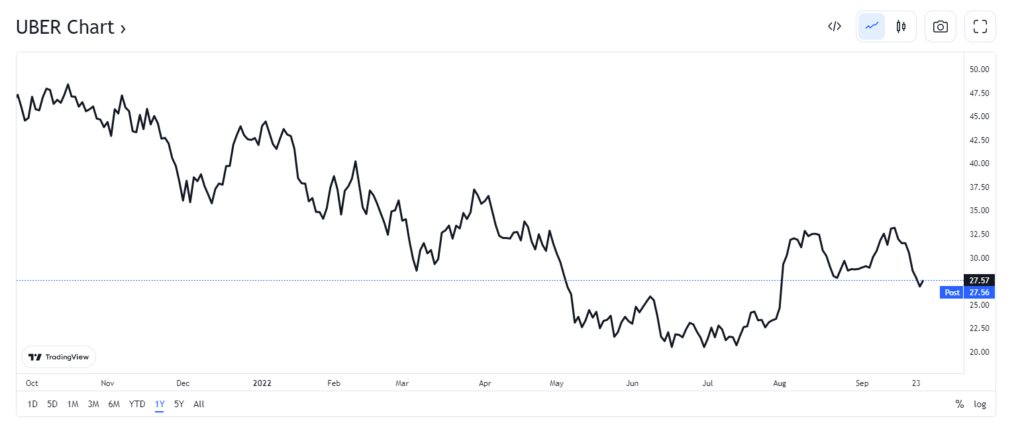Uber Technologies Inc. (NYSE: UBER) made finding a ride as easy as tapping a couple of times on your phone.
It grew into the world’s largest ride-sharing company and expanded to delivery services.
But a fast-growing company like Uber can sometimes run into controversy.
Uber stock currently rates a “High-Risk” 5 out of 100 on our proprietary Stock Power Ratings system.
Let’s take a closer look to see why.
How Uber Came to Be
In 2008, two friends were at a tech conference in Europe.
Garrett Camp and Travis Kalanick desperately needed a ride on a winter night in Paris. That sparked the idea: What if you could request a ride from your phone?
The concept didn’t leave Camp’s mind.
When he returned to San Francisco, Camp bought the domain name UberCab.com.
A year later, he started working on a prototype for UberCab and persuaded his old friend Kalanick to join him in creating this product.
By 2010, Uber ran in New York City with only three cars. A few months later, they launched Uber in San Francisco, and it took off.
UBER Stock History
Uber’s growth out of the gate was incredible.
By 2015, its $51 billion valuation was the most for any startup around the world.
Despite its rapid success, Uber developed a notorious reputation.
Controversies, such as a 2018 fatal crash of a self-driving vehicle from Uber’s services, has made it a tumultuous stock.
One of the biggest disappointments for Uber was the day it went public in 2019.
Analysts declared Uber’s value at $120 billion at the time, which would have made it the largest company to debut on the stock market.
UBER’s initial public offering (IPO) did make history.
It was the most significant first-day dollar loss in U.S. stock market history.
After its IPO, UBER’s value was about $69 billion — just over half its original estimate.
With its tumultuous reputation in mind and years of open trading on the New York Stock Exchange, let’s take a closer look at its Stock Power Ratings.
UBER’s Stock Power Ratings Breakdown
Before we focus on the value and volatility metrics to see why Uber is in the depths of our ratings system, let’s look at its overall score.
UBER stock rates a “High-Risk” 5 out of 100 on our proprietary Stock Power Ratings system. But as for the rest of its ratings, it scores in the red on five out of our six metrics.

UBER’s Stock Power Ratings in September 2022.
- Size — With a market cap of $56.9 billion, Uber is a massive That earns it a 1 on our size metric.
- Quality — I can explain why Uber rates a “Bearish” 21 on quality through numbers: Uber’s return on assets is almost negative 30%, compared to industry averages of negative 8.8%.Its return on equity is also rough at negative 96.6%, compared to the industry average of negative 19.8%.To finish it off: Compared to industry peers, Uber’s net margin is more than 10 times lower at negative 39.4%.
- Momentum — After hitting a 52-week high in October 2021, UBER stock’s steady downward trajectory set in as it dropped 57.7% to a 52-week low in June 2022. This earns Uber a 25 on momentum.
After some upward momentum during the summer rally, the stock is back to trending lower, suggesting optimism was temporary and that the stock may be poised to move lower.
We can look at this further by exploring Uber’s volatility and how that’s affected its value factor rating.
UBER’s Volatility
We can see that Uber’s low volatility score is based on a lot of bumps down the road for the company:
UBER’S 52-Week Stock Performance

Source: Tradingview.
As mentioned in the momentum factor, UBER stock has had a roller coaster of a 52-week performance.
Its downward trajectory affected its stock price.
This earns Uber a 23 on volatility.
We can dive deeper into the performance of the stock by looking at its value.
UBER’s Value
Uber is overvalued compared to industry peers.
To understand this, let’s take a closer look at its price-to ratios.
Its price-to-earnings ratio is N/A.
That means it is negative — or that Uber isn’t making any money!
Uber’s price-to-sales ratio is 2.2, almost four times higher than its industry peers’.
Price-to-book-value ratio is 8.43, compared to the industry average of 1.74.
This staggering difference in ratios means Uber is almost 5X overvalued compared to industry peers.
Combine all of that, and you can see why UBER stock rates a 22 on value.
The Bottom Line
Uber has had a rough go since entering the public market.
Which explains why Uber scores a “High-Risk” 7 out of 100 on our Stock Power Ratings system.
We expect these stocks to underperform the market over the next 12 months.
However, “Strong Bullish” stocks are no anomaly.
We expect those stocks to beat the broader market by 3X in the next 12 months!
To get one highly rated stock you should consider investing in, check out Matt Clark’s Stock Power Daily.
Monday through Friday, he gives you one stock that scores 80 or above on our system and tells you why you should add it to your portfolio — for free!




